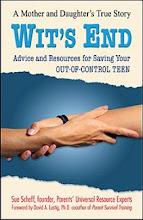
Knowing the Difference: Runaway, Missing or Sneaking?
When a teen turns up "missing," parents must initially decide whether the child is missing, has run away, or simply sneaked out.
There are differences, and those differences are very important. A missing child could have been abducted by someone against his/her will and is being held, possibly threatened. A missing child can also be a child who is simply missing; the child did not return home when expected and may be lost or injured.
Runaway teens and sneaking teens are often confused, as both leave a supervised environment of their own free will. Sneaking teens leave home for a short period of time, with intent to return, most likely during the night or while a parent can be fooled. A runaway teen leaves home or a supervised environment for good, with intent to live separate from his/her parents. Runaway teens will likely have shown symptoms prior to running away.
In most cases, a teen runs away after a frustrating and heated argument with one or both parents. Often times, the runaway will stay with a friend or relative close by to cool off. In more serious cases, a teen may run away often and leave with no notion of where they are going.
Warning Signs your Teen May Become a Runaway
Attempts to communicate with your teen have only resulted in ongoing arguments, yelling, interruptions, hurtful name- calling, bruised feelings and failure to come to an agreement or compromise.
Your teen has become involved in a network of friends or peers who seem often unsupervised, rebellious, defiant, involved with drugs or alcohol or who practice other alarming social behavior.
A noticeable pattern of irrational, impulsive and emotionally abusive behavior by either parent or teen.
The Grass Looks Greener on the Other Side
Often, we hear our teens use "My friend's parents let her do it!" or, "Everything is better at my friend's house!" The parents of your teen's friends may be more lenient, choose later curfew times, allow co-ed events or give higher allowances. While you as parent know all parents work differently, it can be very difficult for your teen to understand.
Motivations of a Runaway
To avoid an emotional experience or consequence that they are expecting as a result of a parental, sibling, friend or romantic relationship/situation.
To escape a recurring or ongoing painful or difficult experience in their home, school or work life.
To keep from losing privileges to activities, relationships, friendships or any other things considered important or worthwhile.
To be with other people such as friends or relatives who are supportive, encouraging and active in ways they feel are missing from their lives.
To find companionship or activity in places that distract them from other problems they are dealing with.
To change or stop what they are doing or about to do.
As parents or guardians we strive to create positive, loving households in order to raise respectful, successful and happy adults. In order to achieve this, rules must be put in place. Teens who run away from home are often crying for attention. Some teens will attempt to run away just once, after an unusually heated argument or situation in the household, and return shortly after. More serious cases, however, happen with teens in extreme emotional turmoil.
Parents also need to be extremely aware of the symptoms, warning signs and dangers of teenage depression. Far too many teens are suffering from this disease and going untreated. Often, runaways feel they have no other choice but to leave their home, and this is in many cases related to their feelings of sadness, anger and frustration due to depression.
Teenage Depression
There are many causes of depression, and every child, regardless of social status, race, age or gender is at risk. Be aware and be understanding. To an adult juggling family and career, it may seem that a young teenager has nothing to be "depressed" about! Work for a mutual communication between the two of you. The more your teenager can confide his/her daily problems and concerns, the more you can have a positive and helpful interaction before the problems overwhelm them.
When a teen turns up "missing," parents must initially decide whether the child is missing, has run away, or simply sneaked out.
There are differences, and those differences are very important. A missing child could have been abducted by someone against his/her will and is being held, possibly threatened. A missing child can also be a child who is simply missing; the child did not return home when expected and may be lost or injured.
Runaway teens and sneaking teens are often confused, as both leave a supervised environment of their own free will. Sneaking teens leave home for a short period of time, with intent to return, most likely during the night or while a parent can be fooled. A runaway teen leaves home or a supervised environment for good, with intent to live separate from his/her parents. Runaway teens will likely have shown symptoms prior to running away.
In most cases, a teen runs away after a frustrating and heated argument with one or both parents. Often times, the runaway will stay with a friend or relative close by to cool off. In more serious cases, a teen may run away often and leave with no notion of where they are going.
Warning Signs your Teen May Become a Runaway
Attempts to communicate with your teen have only resulted in ongoing arguments, yelling, interruptions, hurtful name- calling, bruised feelings and failure to come to an agreement or compromise.
Your teen has become involved in a network of friends or peers who seem often unsupervised, rebellious, defiant, involved with drugs or alcohol or who practice other alarming social behavior.
A noticeable pattern of irrational, impulsive and emotionally abusive behavior by either parent or teen.
The Grass Looks Greener on the Other Side
Often, we hear our teens use "My friend's parents let her do it!" or, "Everything is better at my friend's house!" The parents of your teen's friends may be more lenient, choose later curfew times, allow co-ed events or give higher allowances. While you as parent know all parents work differently, it can be very difficult for your teen to understand.
Motivations of a Runaway
To avoid an emotional experience or consequence that they are expecting as a result of a parental, sibling, friend or romantic relationship/situation.
To escape a recurring or ongoing painful or difficult experience in their home, school or work life.
To keep from losing privileges to activities, relationships, friendships or any other things considered important or worthwhile.
To be with other people such as friends or relatives who are supportive, encouraging and active in ways they feel are missing from their lives.
To find companionship or activity in places that distract them from other problems they are dealing with.
To change or stop what they are doing or about to do.
As parents or guardians we strive to create positive, loving households in order to raise respectful, successful and happy adults. In order to achieve this, rules must be put in place. Teens who run away from home are often crying for attention. Some teens will attempt to run away just once, after an unusually heated argument or situation in the household, and return shortly after. More serious cases, however, happen with teens in extreme emotional turmoil.
Parents also need to be extremely aware of the symptoms, warning signs and dangers of teenage depression. Far too many teens are suffering from this disease and going untreated. Often, runaways feel they have no other choice but to leave their home, and this is in many cases related to their feelings of sadness, anger and frustration due to depression.
Teenage Depression
There are many causes of depression, and every child, regardless of social status, race, age or gender is at risk. Be aware and be understanding. To an adult juggling family and career, it may seem that a young teenager has nothing to be "depressed" about! Work for a mutual communication between the two of you. The more your teenager can confide his/her daily problems and concerns, the more you can have a positive and helpful interaction before the problems overwhelm them.









